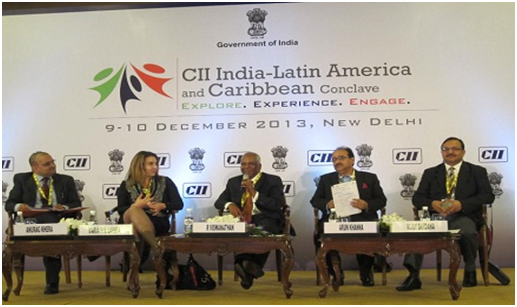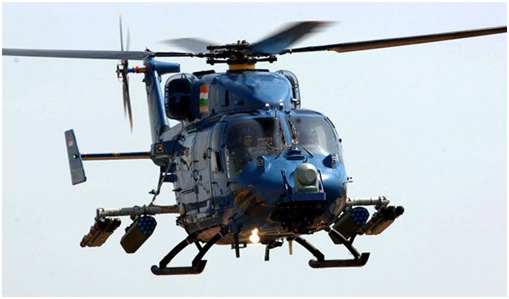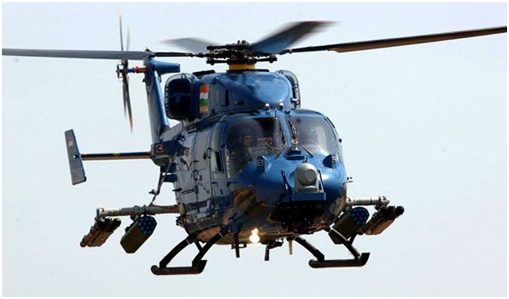By Huma Siddiqui
Development, energy and food security, infrastructural linkages, trade and investment facilitation should be priority
The Latin American region is fast emerging as one of the major growth engines of the world. Like India, Latin America has remained largely resilient to global economic turmoil and has stayed on the path of growth matching India’s attractiveness for investment, which is currently among the top three globally.Today 20 countries of the region have their embassies & consulates in India.
In 1997, taking into consideration the potential for increased trade with Latin America and the Caribbean (LAC), India’s Department of Commerce launched an integrated programme called ‘Focus: LAC’, which has since been extended till end of this year. It aims to encourage the Indian private sector, as well as state entities, to develop stronger trade and investment linkages with Latin America and the Caribbean, and at the same time focus on enhancing India’s export of textiles, engineering products, computer software, chemicals and pharmaceuticals to the region.
In 2014, India is looking at increasing the share of hi-tech and high value-added defence exports to Latin American countries as part of a rejig in its strategy on local defence production. The Commerce Ministry has already indicated its intent of moving Indian exports away from shipments of traditional items without much value-addition. In this regard, an incentive scheme is being considered to boost exports of hi-tech and high value-added defence exports in the forthcoming Foreign Trade Policy (FTP) for 2014-19.
Over the years, India’s ties with Latin America have expanded beyond trade and investment to cooperation in areas such as energy, knowledge sharing as well as in multilateral fora such as G-20, BRICS and IBSA (India, Brazil, South Africa). India enjoys a Preferential Trade Agreement with Mercosur and has been recently granted ‘Observer’ status in the emerging grouping — New Pacific Alliance. These arrangements throw up huge opportunities for the business communities in India and the LAC region, which need to be converted into comprehensive treaties covering trade, services and investments.
 (CII India-Latin America and Caribbean Conclave held in New Delhi on December 9-10, 2013)Formidable challenges
(CII India-Latin America and Caribbean Conclave held in New Delhi on December 9-10, 2013)Formidable challenges
Business relations between India and LAC are mainly by way of investments, as conventional trade in goods has challenges on account of distance, time zone difference and business culture. While trade in commodities continue due to their bulk nature and involvement of mega institutions, manufacturing and services can grow essentially through investments, which will automatically lead to further trade growth.
There is, therefore, a need for a roadmap and agenda for our engagement with Latin America, especially initiatives aimed at meeting the development, energy and food security needs of our region, new infrastructural linkages with enhanced connectivity and trade and investment facilitation that builds on the complementarities in our economic strengths.
Business relations between India and LAC countries face some formidable challenges. The primary reason for low trade and investment is cited as long distances and complicated sea routes, resulting in high transportation and allied costs, such as insurance. There are no direct sea trade routes and shipments have to pass through different ports. Lack of information on how to do business in LAC and India adds to business risks and deters businesses from exploring opportunities.
Challenges to greater economic ties also include a poor understanding of each other, including a major deficit in Spanish and Portuguese language skills in India and lack of proficiency in English in parts of LAC countries.
 (The Vice President, Shri Mohammad Hamid Ansari launching the INCHAM, at Lima in Peru)Trade with the region
(The Vice President, Shri Mohammad Hamid Ansari launching the INCHAM, at Lima in Peru)Trade with the region
Even as India’s trade with the LAC region has grown at 25 per cent annually over the last decade, touching $ 46 billion in 2012-13, bilateral investments remain at a relatively low level. While the region received only 4 per cent of India’s outward FDI, investments from LAC region in India are still low. Now is the time to change that. India, the world’s third largest economy with a $5.5 trillion GDP on purchasing power parity basis, doing business with the $12 trillion LAC economy can make an economic impact, globally. For this, India and LAC countries must rethink their strategy for economic engagement.
Experts say bilateral trade could easily go up to $100 billion if the leaders of both sides blend proactive diplomacy with addressing issues like enhancing connectivity and leveraging opportunities in areas, such as energy, agriculture, food processing, textiles, transport and IT.
R. Vishwanathan, a former Indian Ambassador to the region, suggests that India should sign free trade agreements (FTAs) with Mexico, Colombia and Peru —- the second, third and fourth largest destinations of India’s exports in Latin America. “India must also deepen and widen the preferential trade agreements (PTAs) with Chile and Mercosur countries, including Brazil—the largest destination of India’s exports in the region,” he suggests.
Food & Energy Security
The Indian Government’s focus on food security is another factor behind its deepening engagement with the Latin America region, which has vast swathes of fertile land. Infact, there is immense scope for collaboration between businesses of the India and the LAC region in beefing up India’s food security and in areas relating to development of agriculture and agricultural processing.
A FICCI-Deloitte Paper on `India and Latin America & Caribbean(LAC):Business Environment and Opportunities for Collaboration”, indicates that with climate changes wreaking havoc in the agriculture output, India and LAC could synergise and complement each other to meet the growing food crisis.
Latin America has also emerged as an important source of hydrocarbons for India in the past few years, with the region accounting for around 19 per cent of India’s energy imports. India is also set to step up collaboration with Brazil in the area of eco-friendly ethanol. Venezuela, Colombia, Mexico and Cuba are some of important suppliers of oil to India in the region.
Geographically, India’s major trade partners are Brazil, Venezuela, Mexico, Chile, Argentina and Colombia, with Peru, Ecuador and Panama also significant contributors. These account for more than 80 per cent of the India-LAC trade. Of Caricom countries, Trinidad and Tobago is among the top ten, primarily because of petroleum exports to India.
The Bahamas, curiously, appeared to be the fourth-ranked destination for India’s exports in 2011-2012, but it is generally suspected that this is more reflective of financial transactions passing through that country’s offshore banking system rather than genuine trade.
India’s investments in LAC have been concentrated in natural resource sectors, pharmaceuticals and IT/ITeS. More recently, India has made substantial investments in equity oil. The Indian pharma industry has emerged as a leader in the supply of generic drugs to the world, and LAC is no exception. The sector represents about 15 per cent of India’s exports to the LAC region, making it the second-largest export sector of the region, second only to refined petroleum products. Several Indian pharmaceutical companies are investors and employers in LAC. Ranbaxy, then a fully Indian firm, made a pioneering entry into Brazilin 2000, Dr. Reddy’s Laboratories acquired a plant in Mexico, and Glenmark has invested in Argentina and Brazil. Zydus-Cadila acquired two Brazilian pharma companies and is now a significant player in the market. The largest recipient of Indian investment in pharmaceuticals has been Brazil, followed by Argentina, Mexico, Peru and Colombia.
India’s global leadership in the IT/ITeS sector is well known. Led by Tata Consultancy Services, which entered the LAC region in 2001 as a part of its nearshoring strategy, the roster of Indian companies with direct presence in LAC includes Wipro, Infosys, Mahindra Satyam, Genpact and Evalueserve. There are now 25 Indian IT/ITeS firms in LAC employing over 20,000 Latin American.
Defence & Military Ties
 (HAL ‘Dhruv’ Helicopter) After a clutch of automobile and energy sector investments in the region, state-owned aerospace major Hindustan Aeronautics Limited (HAL) is now looking to make inroads into the lucrative market with its indigenously developed helicopter, `Dhruv’. HAL is in contact with other potential customers in the region and business prospects are being pursued in countries such as Bolivia, Peru, Colombia, Brazil etc. Several countries in the region have also approached Indian companies, especially MSMEs, in the defence and aerospace sectors to set up manufacturing bases in their countries and are offering tax incentives.
(HAL ‘Dhruv’ Helicopter) After a clutch of automobile and energy sector investments in the region, state-owned aerospace major Hindustan Aeronautics Limited (HAL) is now looking to make inroads into the lucrative market with its indigenously developed helicopter, `Dhruv’. HAL is in contact with other potential customers in the region and business prospects are being pursued in countries such as Bolivia, Peru, Colombia, Brazil etc. Several countries in the region have also approached Indian companies, especially MSMEs, in the defence and aerospace sectors to set up manufacturing bases in their countries and are offering tax incentives.
Indian defence firm, MKU Private Limited, manufacturer of ballistic protection equipment for personnel and platforms, has been working with countries such as Brazil, Peru, Chile, Mexico, Colombia, Ecuador, and Paraguay. In fact, since the past seven years, the company has been the sole supplier of body armour to Brazil. It also has the contract to armour M-17 helicopters for the Mexican Navy and Police. Recently, it bagged a deal from Ecuador to supply 40,000 body armours to enhance protection for its police force. MKU had won a global tender in Ecuador for the contract and its body armour was chosen by the Ecuadorean Interior Ministry through extensive tests and field trials before being selected.
Ecuador is also keen on setting up an arms manufacturing factory in India. It may be recalled that Ecuador was among the first countries to import India’s indigenously developed seven ”Dhruv” Advance Light Helicopters (ALH).
Samtel Avionics Ltd has signed an MoU with Avionics Services, Brazil for supplying MFDs for multiple helicopter programmes as well as fixed wing aircraft. The company has also won a trainer programme in South America, and is in talks for transfer of technology on displays.
Conclusion
Trade and investment form the bulwark of the current India-LAC relationship, as both sides are highly complementary in the energy & natural resources, pharmaceuticals, and business services sectors. Diversification of trade partners and access to new markets is also a priority for both sides, especially as Western demand stagnates under the shadow of the global recession.
(Ms Huma Siddiqui is a Senior Correspondent for one of the leading financial dailies, The Financial Express in New Delhi. She specialises in coverage on Latin America & Strategic and Military Issues.)